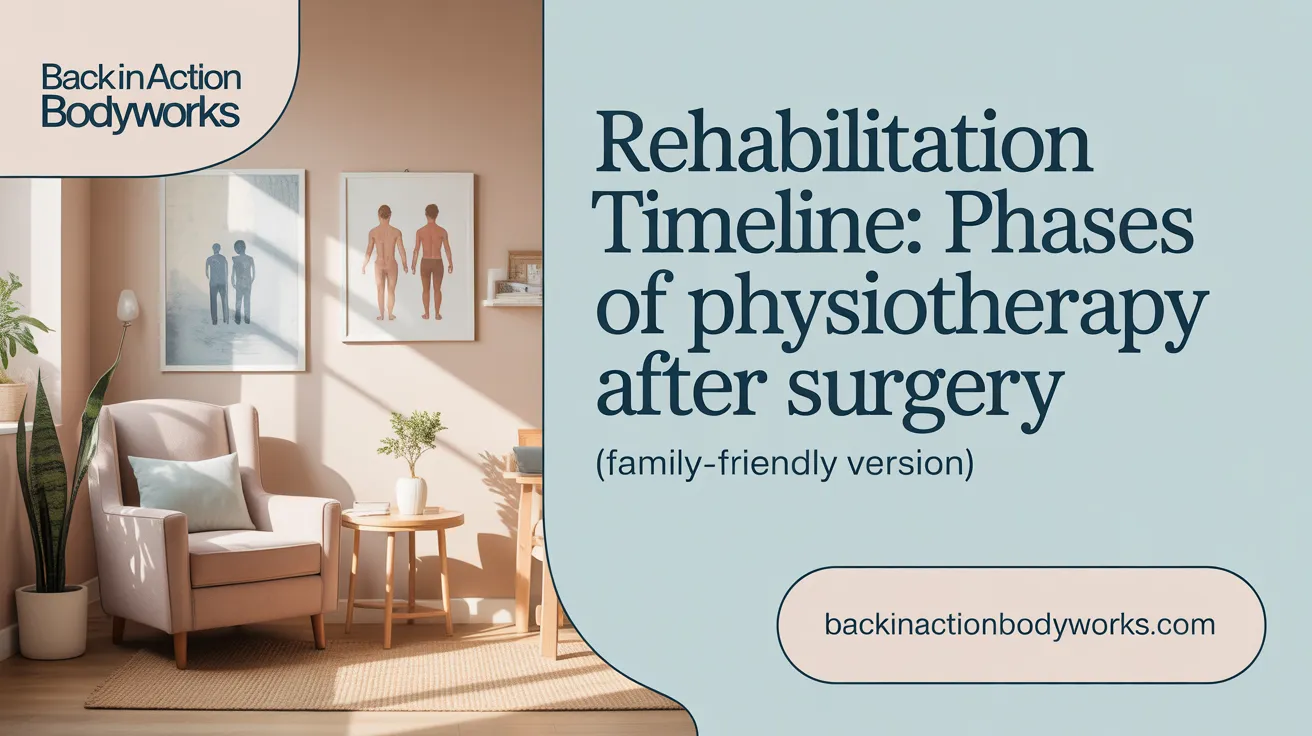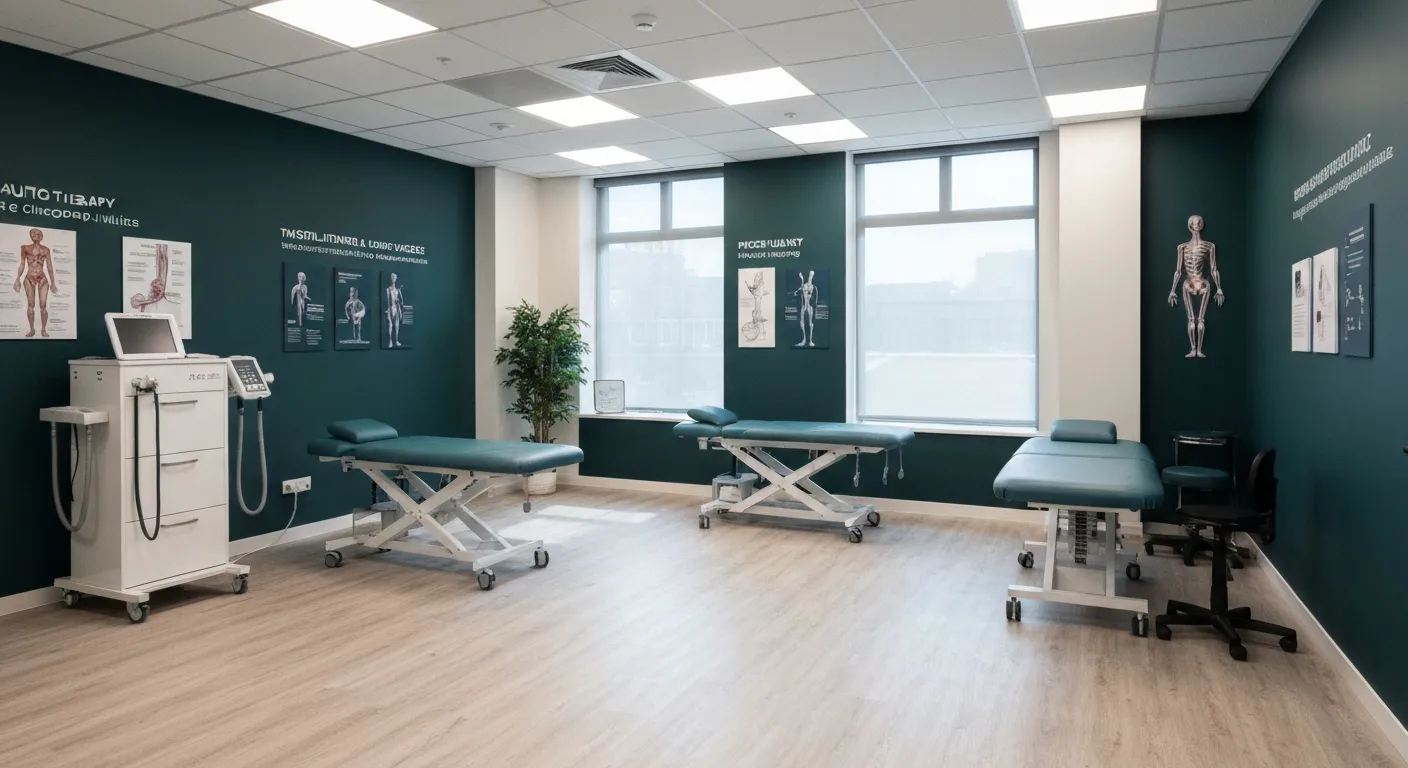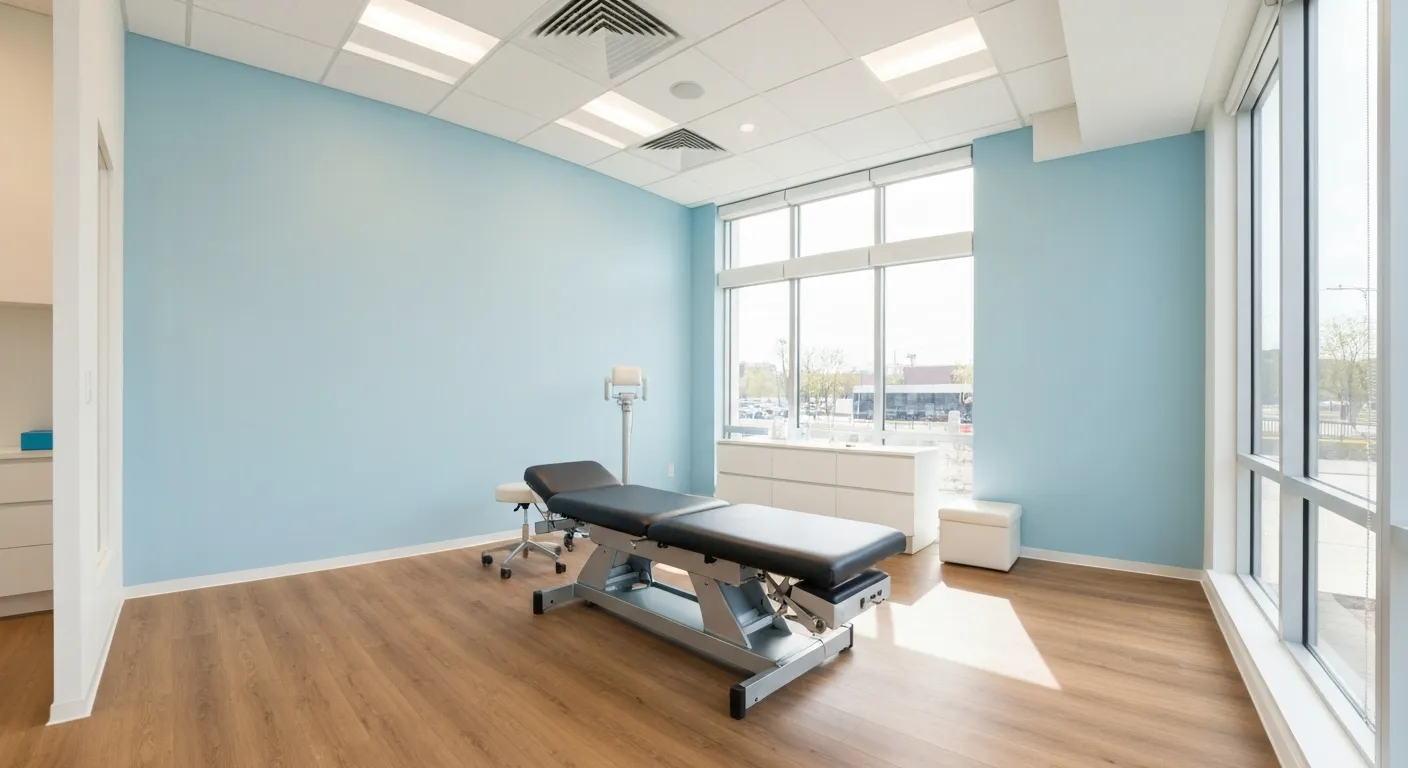How Physiotherapy Helps Post-Surgical Recovery
September 11, 2025
9 min

Understanding Post-Surgical Physiotherapy
Physiotherapy plays a crucial role in helping patients regain strength, mobility, and function following surgery. It is a personalized, targeted treatment approach that supports healing, prevents complications, and accelerates recovery. This article explores how physiotherapy contributes to post-surgical recovery, detailing the benefits, phases, techniques, and evidence that underscore its importance in enhancing recovery outcomes and improving quality of life.
The Essential Role of Physiotherapy in Post-Surgical Healing and Recovery

What is the role of physiotherapy in post-surgical recovery and healing?
Physiotherapy plays a crucial role after surgery by actively supporting healing and restoring physical function. It helps accelerate tissue repair through techniques that improve blood circulation and reduce swelling, pain, and stiffness. Tailored exercises and manual therapies assist in regaining joint mobility and strengthening muscles weakened during immobilization.
Through early movement and guided activity, physiotherapy prevents long-term issues such as joint stiffness, scar tissue buildup, and muscle atrophy. It also manages pain effectively, often reducing reliance on medications, and ensures a safe and progressive return to everyday activities.
Personalized plans are designed based on each patient’s condition, surgery type, and recovery goals. This individualized approach ensures optimal outcomes, speeds up functional recovery, and helps individuals regain their independence.
Beyond physical benefits, physiotherapy offers psychological support by improving confidence, reducing anxiety about movement, and empowering patients throughout their recovery journey. Education on proper body mechanics and self-care further minimizes the risk of re-injury and future problems.
Overall, physiotherapy shortens recovery time, boosts overall quality of life, and plays an indispensable role in helping patients return to their normal routines faster and safer.
Key Benefits of Physiotherapy Following Surgery

What are the benefits of physiotherapy after surgery?
Physiotherapy after surgery offers numerous advantages vital for a complete recovery. It helps restore joint mobility, flexibility, and muscle strength, allowing patients to regain their independence and perform daily activities safely.
One of the most significant benefits is pain reduction. Through manual therapy, controlled exercises, and modalities like ice or heat therapy, physiotherapy helps decrease post-operative pain and stiffness. This not only enhances comfort but also reduces dependence on pain medications.
Physiotherapy also plays a preventive role by minimizing complications such as blood clots, infections, and muscle atrophy. Proper movement and blood circulation promoted during therapy contribute to faster healing and decrease the risk of secondary problems.
Scar tissue management is another crucial aspect. Techniques like massage and ultrasound help break down excessive scar tissue, maintaining tissue elasticity and preventing long-term joint restrictions.
Overall, engaging in tailored physiotherapy accelerates the healing process and fosters a quicker return to normal functions. It improves mobility and strength, helps restore confidence, and significantly enhances the overall quality of life post-surgery.
| Benefit | Description | Additional Points |
|---|---|---|
| Pain reduction | Manual therapy, exercises, modalities | Decreases reliance on medication |
| Improved mobility | Stretching, strengthening exercises | Restores independence |
| Complication prevention | Blood flow, movement | Reduces risks like blood clots |
| Scar tissue management | Massage, ultrasound | Maintains tissue flexibility |
| Faster healing | Guided exercises, circulation | Returns patients to daily life sooner |
Common Techniques and Procedures in Post-Surgical Physiotherapy

Post-surgical physiotherapy uses a diverse set of techniques and procedures to support healing and restore function. One of the main approaches is manual therapy, which includes massage, joint mobilization, and manipulation. These techniques help reduce pain, improve tissue mobility, and break down scar tissue to maintain or restore flexibility.
Therapeutic exercises are central to physiotherapy recovery. These include range of motion exercises to prevent stiffness, strengthening routines to rebuild muscle support around joints, stretching to maintain flexibility, and balance and coordination activities. These exercises are customized and progressively adjusted to match the patient’s healing stage and individual goals.
To manage pain and swelling, physiotherapists often utilize modalities like ultrasound, electrical stimulation, and ice or heat therapy. Ultrasound can promote tissue healing and reduce inflammation, while electrical stimulation helps with pain control and muscle activation. Ice or heat application can decrease swelling and comfort the patient during recovery.
Airway clearance methods are particularly important after thoracic or abdominal surgeries. Techniques such as breathing exercises, inspiratory muscle training, and postural drainage help improve lung expansion, prevent pneumonia, and reduce the risk of pulmonary complications. These procedures often include guided breathing strategies and positioning to optimize airway function.
Early mobilization and gait training are critical components of post-surgical care. They help normal movement patterns, restore strength, reduce blood clots, and improve circulation. The rehabilitation plan is tailored to the type of surgery, patient health status, and recovery goals.
In summary, post-surgical physiotherapy combines manual therapy, therapeutic exercises, specialized modalities, and airway management techniques. These interventions work together to speed up healing, reduce complications, and enhance overall recovery outcomes.
Phases and Timing of Physiotherapy in Post-Surgical Rehabilitation

What are the typical phases and timing of physiotherapy during post-surgical rehabilitation?
Post-surgical physiotherapy generally follows a structured approach divided into several key phases, each with specific goals aligned with the healing and recovery process.
Initial Acute or Healing Phase (First 1-4 weeks)
The primary focus during this early period is to control pain, reduce swelling, and promote tissue repair. Physiotherapists prioritize gentle mobilization, wound care, and breathing exercises. This phase often involves minimal movement activities aimed at protecting the surgical site while encouraging circulation to prevent blood clots like deep vein thrombosis (DVT).
Mobility and Early Strengthening Phase (Approximately 4-7 weeks)
Once initial healing is underway, the focus shifts to regaining joint range of motion and preventing stiffness. Physiotherapists introduce joint mobilization, stretching, and controlled isotonic exercises. Early strengthening exercises are incorporated to stimulate muscle activity without overloading the tissue.
Rebuilding Strength and Functional Mobility (Around 6-12 weeks)
In this stage, resistance training becomes more prominent to restore muscle strength, endurance, and stability. Balance and proprioception exercises are added to enhance coordination. The goal is to facilitate a safe return to daily activities and basic functional movements.
Advanced Functional and Sport-specific Phase (Beyond 3 months)
The final stage aims for full recovery and return to pre-surgery activity levels, including sports or work-specific tasks. Activities become more dynamic, involving higher resistance, complex movements, and functional drills tailored to individual goals.
Timing and Individualization
Although these phases typically follow a general timeline, the pace of progression depends on the patient’s healing response, type of surgery, age, and activity level. Regular assessment ensures treatment is adapted appropriately, accelerating recovery while minimizing risks.
Summary of Typical Timelines
| Phase | Duration | Focus | Main Activities | Key Goals |
|---|---|---|---|---|
| Acute healing | 1-4 weeks | Pain, swelling, tissue repair | Gentle mobilization, pain control | Reduce complications, protect tissue |
| Mobility & early strength | 4-7 weeks | Range of motion, initial strength | Stretching, controlled exercises | Prevent stiffness, promote early strength |
| Strength & functional mobility | 6-12 weeks | Muscle rebuilding, stability | Resistance, balance exercises | Restore independence and balance |
| Functional & sport readiness | 3+ months | Return to activity | Dynamic and sport-specific drills | Full functionality and confidence |
How does physiotherapy adapt to individual progress?
Treatment plans are personalized based on ongoing assessments. If a patient demonstrates faster healing or higher baseline fitness, progression may be quicker. Conversely, slower healing or complications necessitate a more cautious approach. Telephone follow-ups, in-clinic evaluations, and patient feedback ensure the rehabilitation timeline remains aligned with individual needs.
In summary, physiotherapy after surgery is a phased process that evolves according to the patient’s unique recovery journey, promoting optimal outcomes and long-term functionality.
Approaches and Methods to Optimize Physiotherapy Effectiveness

What approaches and methods ensure effective physiotherapy in recovery after surgery?
Effective physiotherapy after surgery relies heavily on personalized treatment strategies tailored to each patient’s specific condition. The initial assessment by a physiotherapist is crucial to understand the unique limitations, pain levels, and functional goals. This assessment guides the development of an individualized plan that emphasizes gradual progression in exercises to rebuild strength, improve mobility, and restore normal movement patterns.
Incorporating a combination of treatment modalities enhances recovery. Techniques such as manual therapy, which includes joint mobilizations and soft tissue massage, are used to reduce pain and improve tissue flexibility. Therapeutic exercises focus on stretching and strengthening targeted muscles, while modalities like electrotherapy and ultrasound help decrease inflammation and support tissue healing.
Starting physiotherapy early—often within 24 to 48 hours post-surgery—can significantly influence outcomes. Early intervention promotes circulation, reduces stiffness, and prevents complications like blood clots or muscle atrophy. Therapy sessions typically last between 30 to 60 minutes daily, focusing on pain management, restoring range of motion, and rebuilding strength.
Patient education is a cornerstone of effective physiotherapy. Clear guidance on self-management techniques, home exercises, and activity modifications empowers patients to actively participate in their recovery. Motivation and adherence to prescribed programs are vital, as they directly impact the speed and quality of healing.
To maximize benefits, a multidisciplinary approach often integrates other healthcare professionals and modalities, such as assistive devices, electrotherapy, or dry needling, as needed. Regular monitoring and adjustments to the treatment plan ensure that progress aligns with recovery goals.
In summary, the most successful physiotherapy strategies combine personalized care, early intervention, multimodal treatments, and patient engagement. This comprehensive approach promotes faster healing, reduces complications, and restores function efficiently.
| Aspect | Description | Additional Notes |
|---|---|---|
| Treatment Planning | Personalized, based on assessment | Focused on specific limitations and goals |
| Modalities Used | Manual therapy, exercises, electrotherapy | Supports pain relief and tissue healing |
| Timing | Initiates within 24-48 hours | Promotes circulation and reduces stiffness |
| Session Duration | 30-60 minutes daily | Consistent frequency for optimal recovery |
| Patient Engagement | Education, motivation, adherence | Enhances outcomes and sustainability |
| Collaboration | Multidisciplinary, including assistive devices | Ensures comprehensive care |
Effective post-surgical physiotherapy combines tailored interventions, early and consistent treatment, patient-centered education, and collaborative healthcare for best results.
Scientific Evidence Supporting Physiotherapy Post-Surgery

What does scientific research say about the effectiveness of physiotherapy post-surgery?
Research consistently demonstrates that physiotherapy is a valuable part of recovery after various surgeries. Studies show that physiotherapy improves muscle strength, mobility, and function, ultimately leading to better long-term outcomes. Patients who undergo physiotherapy tend to experience less pain, reduced stiffness, and increased confidence in movement. Systematic reviews highlight its role in reducing persistent postoperative pain and enhancing overall quality of life.
For specific types of surgeries, especially orthopedic procedures like joint replacements, physiotherapy accelerates rehabilitation by promoting early movement and restoring range of motion. Evidence from randomized controlled trials indicates that early physiotherapy interventions can shorten recovery time, decrease reliance on pain medications, and prevent complications such as blood clots or muscle atrophy.
Preoperative physiotherapy or "prehabilitation," involving breathing exercises and strengthening routines, has also proven beneficial. It prepares patients physically and psychologically, reducing the risk of postoperative pulmonary issues and improving surgical outcomes.
However, some research has shown variability in results. For example, a cohort study on spine surgery patients found that inpatient physiotherapy might slightly increase hospital stays without significantly lowering complication or readmission rates. This suggests that the timing and individual patient factors play critical roles in therapy effectiveness.
Overall, the consensus underscores physiotherapy as an essential, evidence-based strategy for optimal post-surgical recovery. Tailoring treatment plans based on procedure type, patient condition, and timing can maximize benefits and improve quality of life.
Educating Patients: Empowering Recovery Through Physiotherapy

Physiotherapy plays a vital role in guiding patients through their post-surgical recovery journey by providing detailed education on exercises and precautions. Initially, physiotherapists evaluate the patient’s condition and develop a tailored plan that explains the purpose of each activity, teaching patients how to perform movements safely. This includes instruction on proper body mechanics and posture to prevent further injury and promote optimal healing.
Patients are educated on pain management techniques, such as gradual movement and scar tissue care, to reduce discomfort and prevent complications like adhesions. Guidance on the use of assistive devices, safe gait patterns, and activity modifications helps patients regain confidence and independence.
Beyond physical instructions, physiotherapists offer psychological support by motivating patients, addressing fears, and setting realistic recovery goals. They also stress the importance of self-care strategies, such as home exercises, proper nutrition, and activity pacing, which are crucial for long-term recovery.
Through this comprehensive educational approach, patients become active participants in their rehabilitation. Understanding their treatment benefits enhances adherence, accelerates healing, and supports a smooth transition back to everyday activities, ultimately improving overall outcomes.
Maximizing Recovery with Physiotherapy
Physiotherapy is a cornerstone of post-surgical recovery, providing targeted treatments that accelerate healing, restore mobility, and rebuild strength. Through carefully structured phases and evidence-based techniques, it not only addresses physical impairments but also offers psychological support and education, empowering patients to regain independence and return to everyday activities confidently. Scientific research affirms the value of physiotherapy in improving recovery outcomes, although individualized care and timing remain critical. Ultimately, embracing physiotherapy throughout the surgical journey—from prehabilitation to long-term rehabilitation—maximizes healing potential, reduces complications, and enhances quality of life post-surgery.
References
- How Physiotherapy Can Aid Recovery Post-Surgery
- Assessing the effectiveness of routine use of post-operative ...
- Physiotherapy Post Surgery
- Role of Physiotherapist in Pre & Post-Surgical Rehabilitation
- From Stiffness to Strength: How Physiotherapy Aids Post- ...
- Surgery Recovery with Physiotherapy
- Physiotherapy for Post-Surgical Healing
- Regaining Mobility After Surgery - CURA Physical Therapies
- Post Operative Physiotherapy
Recent articles

Corrective Exercises That Help Prevent Recurring Pain

8 Corrective Exercises Proven for Lasting Pain Relief

Lifestyle Habits for Maintaining a Healthy Spine

What You Will Experience at Your Initial Chiropractic Visit

What Happens at Your First Visit to a Chiropractor?

Focusing on Root Cause Analysis for Effective Pain Relief

Tips for Lifestyle Changes to Support Spinal Health

Holistic Treatment Plans: Alternatives to Surgery for Chronic Pain

Enhance Wellness Through Personalized Nutritional Counseling

Non-Invasive Pain Relief: Exploring Holistic Treatment Alternatives

Sciatica Relief Through Targeted Spinal Decompression

Integrating Physiotherapy with Chiropractic Treatments for Better Results

Testimonials That Demonstrate the Benefits of Chiropractic Care

The Power of Corrective Exercises in Pain Management

A Step-by-Step Guide to Your Initial Chiropractic Consultation

9 Nutritional Tips to Enhance Your Chiropractic Wellness Journey

Patient Experiences: How Chiropractic Care Changed Their Lives

Lifestyle Recommendations to Keep Your Spine in Top Shape

Effective Corrective Exercises for Long-Term Pain Relief

Back Pain Benefits: What Chiropractic Care Can Do for You

Spinal Decompression Techniques for Effective Sciatica Relief

Top Nutritional Counseling Tips for Enhanced Wellness

6 Lifestyle Habits That Boost Spine Health Daily

Discover Holistic and Non-Surgical Pain Relief Solutions

Exploring Holistic and Non-Surgical Treatment Options for Pain

The Role of Physiotherapy in Enhancing Chiropractic Care Outcomes

Complementing Chiropractic Care with Physiotherapy: What You Need to Know

What to Expect During Your First Chiropractic Visit

Simple Lifestyle Adjustments to Maintain a Healthy Spine

Personalized Nutritional Counseling for Improved Health Outcomes

Exploring Non-Surgical Treatments for Spine-Related Conditions

An Introduction to Spinal Decompression for Sciatica Patients

Transformative Success Stories: Patient Experiences with Chiropractic Treatments

Why Chiropractic Care Is Essential for Back Pain Relief

Addressing Underlying Causes Versus Symptom Management in Pain Care

The Role of Nutrition in Enhancing Chiropractic Treatment Effectiveness

Sciatica Treatment Options: Is Spinal Decompression Right for You?

Lifestyle Tips to Maintain a Healthy Spine and Prevent Back Issues

The Synergy Between Physiotherapy and Chiropractic Treatments

What Happens During Your Initial Chiropractic Consultation

Effective Corrective Exercises for Sustainable Pain Management

Taking a Root Cause Approach to Chronic Pain Management

Holistic Pain Management Techniques Without Surgery

How Patient Success Stories Validate Chiropractic Care Benefits

Spinal Decompression: Innovative Treatment for Sciatic Nerve Pain

Spinal Decompression Therapy: A Non-Invasive Approach to Sciatica Relief

Exploring Holistic Approaches Beyond Surgery for Pain Relief

Practical Lifestyle Advice to Support a Healthy Spine Every Day

Corrective Exercise Routines Designed for Long-Term Pain Prevention

Real Patient Stories: Overcoming Chronic Pain with Chiropractic Care

Lifestyle Changes That Promote a Healthy Spine and Prevent Injury

How Addressing the Root Cause of Pain Leads to Lasting Relief

Non-Surgical Holistic Therapies to Manage Chronic Pain Effectively

Nutritional Counseling's Impact on Physical Health and Healing

Benefits of Regular Chiropractic Care for a Stronger Back

Your First Chiropractic Visit: What to Expect and How to Prepare

Patient Experiences: How Chiropractic Care Transformed Their Lives

Exploring Holistic, Non-Surgical Options for Pain Management

Combining Physiotherapy with Chiropractic Treatments for Enhanced Recovery

Holistic Treatments That Offer Alternatives to Surgery for Pain Relief

Corrective Exercise Strategies for Long-Term Spine Health

How Physiotherapy Complements Chiropractic Adjustments for Better Outcomes

First-Time Chiropractic Visitors: What You Should Know

Understanding the Importance of Treating Pain at Its Source

Adopting Lifestyle Changes to Support Your Spine's Wellness

Utilizing Physiotherapy to Enhance Chiropractic Treatment Outcomes

The Key Advantages of Chiropractic Care for Back Pain Sufferers

Why Focusing on Root Causes Improves Pain Treatment Success

Corrective Exercises That Promote Lasting Pain Relief and Mobility

Sciatica Relief Through Targeted Spinal Decompression Techniques

Preparing for Your First Chiropractic Appointment with Confidence

Healthy Lifestyle Habits for Maintaining Spinal Alignment

Success Stories Highlighting Chiropractic's Role in Pain Recovery

Top Benefits of Chiropractic Care for Chronic Back Pain

Nutrition Tips to Boost Your Overall Wellness and Recovery

How Chiropractic Care Alleviates Back Pain Naturally

How Nutritional Counseling Supports Overall Wellness and Spine Health

Step-by-Step Guide to Your First Visit with a Chiropractor

Using Nutrition to Support Chiropractic and Overall Wellness

Integrating Physiotherapy in Your Chiropractic Healing Journey

How Physiotherapy Complements Chiropractic Adjustments for Faster Healing

Lifestyle Tips for Maintaining a Healthy Spine and Preventing Back Pain

Heartwarming Patient Testimonials Highlighting Chiropractic Success

How Proper Nutrition Supports Chiropractic and Physiotherapy Treatments

Combining Physiotherapy and Chiropractic Treatments for Optimal Recovery

Why Chiropractic Treatments Are Effective for Managing Back Pain

Choosing a Chiropractor: Tips for Finding a Trusted Provider

Integrating Physiotherapy and Chiropractic: Benefits and What to Expect

How Tailored Corrective Exercises Can Aid in Pain Management

Chiropractic Care: A Proven Solution for Alleviating Back Pain

What to Expect at Your First Chiropractic Visit: A Comprehensive Guide

The Importance of Root Cause Analysis in Effective Pain Management

The Role of Corrective Exercises in Sustaining Pain-Free Living

Combining Chiropractic and Physiotherapy for Comprehensive Pain Relief

How Addressing Underlying Causes Improves Pain Treatment Effectiveness

Maintaining Spinal Health Through Lifestyle Changes and Preventive Care

Understanding the Benefits of Chiropractic Adjustments for Back Pain Sufferers

Spinal Decompression Therapy: A New Hope for Sciatica Relief

Lifestyle Recommendations to Support a Healthy Spine and Reduce Pain

